Increasing the Efficiency of Sealing the Borehole in Terms of Spacer Pumping Time
Abstract
:1. Introduction
2. Materials and Methods
2.1. Materials
2.2. Preparation of the Cement Slurry
2.3. Experimental Procedures
- PN-EN ISO 10426-2. Oil and gas industry. Cements and materials for cementing holes. Lot 2: Testing of drilling cements. In these tests, the following were measured: slurry density, filtration, and thickening time.
- PN-EN 196-1: 2006 Cement testing methods. Strength marking.
3. Results and Discussion
4. Conclusions
- On the basis of the obtained test results, the efficiency of mud cake removal largely depends on the wash contact time in the annular space.
- The effectiveness of mud cake removal from a borehole is mainly determined by the type of flow, i.e., the amount of wash contact.
- Although increasing the wash contact time improves the mud cake removal efficiency, it may damage the weakly compact zone; therefore, the required wash contact time and delivery rate for a given borehole must not be exceeded.
- The tested wash contact times resulted in adhesion values ranging from 1.07 MPa to 1.77 MPa (adhesion of the sample with the mud cake was 0.61 MPa, while the baseline sample without the mud cake had an adhesion of 2.37 MPa).
- The obtained test results show that the adhesion improved by 75–189% relative to the minimum baseline value for a cement slurry based on class G drilling cement.
- Comparing the obtained mud cake removal values to the maximum value of the baseline adhesion (removal of 100% of the mud cake), the improvement in the mud cake removal efficiency ranged from 45% after 4 min of wash contact to 74% after 10 min of wash contact.
- The analysis of the obtained test results shows that the optimal wash contact time was 6 min, which resulted in 63% efficiency in removing the mud cake.
- Tests on the effectiveness of mud cake removal under laboratory conditions do not completely replicate actual borehole conditions, but the constructed drilling fluid flow simulator allows borehole conditions to be reproduced to a large extent.
Author Contributions
Funding
Institutional Review Board Statement
Informed Consent Statement
Data Availability Statement
Acknowledgments
Conflicts of Interest
Nomenclature
| kN | Kilonewton |
| MPa | Megapascal |
| PCV | Polyvinyl chloride |
| µm | Micrometer |
References
- Błaż, S. Nowe rodzaje cieczy przemywających osady z płuczki inwersyjnej przed zabiegiem cementowania otworów wiertniczych. Nafta-Gaz 2017, 5, 302–311. [Google Scholar] [CrossRef]
- Jasiński, B. Ocena wpływu cieczy przemywającej na jakość zacementowania rur w otworze wiertniczym po użyciu płuczki glikolowo-potasowej. Nafta-Gaz 2016, 6, 413–421. [Google Scholar] [CrossRef]
- Adari, R.B.; Miska, S.; Kuru, E.; Bern, P.A.; Saasen, A. Selecting drilling fluid properties and flow rates for effective hole cleaning in high-angle and horizontal wells. In Proceedings of the Paper Presented at the SPE Annual Technical Conference and Exhibition, Dallas, TX, USA, 1–4 October 2000. [Google Scholar]
- Zima, G. Wpływ właściwości płuczek wiertniczych na jakość cementowania w gazonośnych poziomach miocenu. Nafta-Gaz 2014, 12, 899–907. [Google Scholar]
- Kremieniewski, M. Influence of Graphene Oxide on Rheological Parameters of Cement Slurries. Energies 2020, 13, 5441. [Google Scholar] [CrossRef]
- Huang, S.; Feng, B.; Li, Z.; Tang, S.; Li, J.; Su, D.; Qi, L. Remediation of oil-based mud contaminated cement with talcum in shale gas well primary cementing: Mechanical properties, microstructure, and hydration. Constr. Build. Mater. 2021, 300, 124047. [Google Scholar] [CrossRef]
- Zhang, F.; Miska, S.; Yu, M.; Ozbayoglu, E.; Takach, N.; Osgouei, R.E. Is well clean enough? A fast approach to estimate hole cleaning for directional drilling. In Proceedings of the Paper Presented at the SPE/ICoTA Coiled Tubing & Well Intervention Conference & Exhibition, The Woodlands, TX, USA, 24–25 March 2015. [Google Scholar]
- Ahmed, A.; Mahmoud, A.A.; Elkatatny, S.; Chen, W. The effect of weighting materials on oil-well cement properties while drilling deep wells. Sustainability 2019, 11, 6776. [Google Scholar] [CrossRef] [Green Version]
- Kremieniewski, M.; Rzepka, M. Przyczyny i Skutki Przepływu Gazu w Zacementowanej Przestrzeni Pierścieniowej Otworu Wiertniczego Oraz Metody Zapobiegania Temu Zjawisku; Nafta-Gaz: Hünenber, Switzerland, 2016; p. 9. [Google Scholar]
- Kmieć, M.; Karpiński, B.; Antoszkiewicz, M.; Szkodo, M. Laboratory research on the influence of swelling clay on the quality of borehole cementing and evaluation of clay-cutting wellbore tool prototype. Appl. Clay Sci. 2018, 164, 13–25. [Google Scholar] [CrossRef]
- Kremieniewski, M. Ocena Skuteczności Oczyszczania Kolumny Rur Okładzinowych Przed Cementowaniem na Podstawie Badań Przy Użyciu Wiskozymetru Obrotowego; Nafta-Gaz: Hünenber, Switzerland, 2018; Volume 9, pp. 59–66. [Google Scholar]
- Boyou, N.V.; Ismail, I.; Sulaiman, W.R.W.; Haddad, A.S.; Husein, N.; Hui, H.T.; Nadaraja, K. Experimental investigation of hole cleaning in directional drilling by using nano-enhanced water-based drilling fluids. J. Pet. Sci. Eng. 2019, 176, 220–231. [Google Scholar] [CrossRef] [Green Version]
- Kremieniewski, M.; Kędzierski, M. Badanie Frakcjonowania Lekkich Materiałów Obniżających Gęstość Jako Wstępnego Parametru Podczas Projektowania Receptury Zaczynu Lekkiego; Nafta-Gaz: Hünenber, Switzerland, 2019; Volume 12, pp. 35–42. [Google Scholar]
- Saasen, A. Hole cleaning during deviated drilling—The effects of pump rate and rheology. In Proceedings of the Paper Presented at the European Petroleum Conference, The Hague, The Netherlands, 20–22 October 1998. [Google Scholar]
- Yu, M.; Takach, N.; Nakamura, E.; David, R.; Shariff, M.M. An experimental study of hole cleaning under simulated downhole conditions. In Proceedings of the Paper Presented at the SPE Annual Technical Conference and Exhibition, Anaheim, CA, USA, 11–14 November 2007. [Google Scholar]
- Wiśniowski, R.; Skrzypaszek, K.; Małachowski, T. Selection of a suitable rheological model for drilling fluid using applied numerical methods. Energies 2020, 13, 3192. [Google Scholar] [CrossRef]
- Kremieniewski, M. Korelacja Skuteczności Działania Środków Dyspergujących o Różnym Mechanizmie Upłynniania; Nafta-Gaz: Hünenber, Switzerland, 2020; pp. 816–826. [Google Scholar]
- Kateev, R.I. Casing of Wells in Abnormal Hydrodynamic Conditions of the Development of Oil Fields in Tatarstan; Nedra: Moscow, Russia, 2005; pp. 65–67. [Google Scholar]
- Kremieniewski, M. Ultra-lightweight cement slurry to seal wellbore of poor wellbore stability. Energies 2020, 13, 3124. [Google Scholar] [CrossRef]
- Ryan, D.F.; Browne, S.V.; Burnham, M.P. Mud clean-up in horizontal wells: A major joint industry study. In Proceedings of the Paper Presented at the SPE Annual Technical Conference and Exhibition, Dallas, TX, USA, 22–25 October 1995. [Google Scholar]
- Kremieniewski, M. Receptura zaczynu lekkiego do uszczelniania otworów w strefie niskich ciśnień złożowych. Nafta-Gaz 2020, 9, 577–584. [Google Scholar] [CrossRef]
- Sifferman, T.; Becker, T. Hole Cleaning in Full-Scale Inclined Wellbores. SPE Drill. Eng. 1992, 7, 115–120. [Google Scholar] [CrossRef]
- Saasen, A.; Løklingholm, G. The effect of drilling fluid rheological properties on hole cleaning. In Proceedings of the Paper Presented at the IADC/SPE Drilling Conference, Dallas, TX, USA, 11 February 2002. [Google Scholar]
- Kremieniewski, M. Recipe of lightweight slurry with high early strength of the resultant cement sheath. Energies 2020, 13, 1583. [Google Scholar] [CrossRef] [Green Version]
- Okrajni, S.; Azar, J. The Effects of Mud Rheology on Annular Hole Cleaning in Directional Wells. SPE Drill. Eng. 1986, 1, 297–308. [Google Scholar] [CrossRef]
- Sanchez, R.A.; Azar, J.J.; Bassal, A.A.; Martins, A.L. The effect of drillpipe rotation on hole cleaning during directional well drilling. In Proceedings of the Paper Presented at the SPE/IADC Drilling Conference, Amsterdam, The Netherlands, 4–6 March 1997. [Google Scholar]
- Li, Z.; Su, G.; Zheng, L. Enhancing filter cake removal by engineering parameter optimization for clean development of fossil hydrogen energy: A numerical simulation. Int. J. Hydrogen Energy 2021, 46, 12784–12800. [Google Scholar] [CrossRef]
- Kremieniewski, M. Hybrid Washer Fluid for Primary Cementing. Energies 2021, 14, 1295. [Google Scholar] [CrossRef]
- Kremieniewski, M. Badania środków poprawiających stabilność sedymentacyjną zaczynów cementowych. Nafta-Gaz 2020, 6, 387–395. [Google Scholar] [CrossRef]
- Hirpa, M.M.; Arnipally, S.K.; Kuru, E. Effect of the particle size on the near-wall turbulence characteristics of the polymer fluid flow and the critical velocity required for particle removal from the sand bed deposited in horizontal wells. Energies 2020, 13, 3172. [Google Scholar] [CrossRef]
- Valluri, S.G.; Miska, S.; Yu, M.; Ahmed, R.M.; Takach, N. Experimental study of effective hole cleaning using sweeps in horizontal wellbores. In Proceedings of the Paper Presented at the SPE Annual Technical Conference and Exhibition, San Antonio, TX, USA, 24–27 September 2006. [Google Scholar]
- Bilgesu, H.; Nekkhil, I.M.; Ameri, S. Understanding the effect of drilling parameters on hole cleaning in horizontal and deviated wellbores using computational fluid dynamics. In Proceedings of the Paper Presented at the Eastern Regional Meeting, Lexington, KY, USA, 17–19 October 2007. [Google Scholar]
- Kremieniewski, M.; Kędzierski, M. Badania nad opracowaniem hybrydowej cieczy buforowej. Nafta-Gaz 2020, 76, 517–526. [Google Scholar] [CrossRef]
- Zamora, M.; Jefferson, D.T.; Powell, J.W. Hole-cleaning study of polymer-based drilling fluids. In Proceedings of the Paper Presented at the SPE Annual Technical Conference and Exhibition, Houston, TX, USA, 3–6 October 1993. [Google Scholar]
- Sayindla, S.; Lund, B.; Ytrehus, J.D.; Saasen, A. Hole-cleaning performance comparison of oil-based and water-based drilling fluids. J. Pet. Sci. Eng. 2017, 159, 49–57. [Google Scholar] [CrossRef] [Green Version]
- Li, J.; Walker, S.A. Sensitivity Analysis of Hole Cleaning Parameters in Directional Wells. SPE J. 2001, 6, 356–363. [Google Scholar] [CrossRef]
- Bizhani, M.; Corredor, F.E.R.; Kuru, E. Quantitative Evaluation of Critical Conditions Required for Effective Hole Cleaning in Coiled-Tubing Drilling of Horizontal Wells. SPE Drill. Complet. 2016, 31, 188–199. [Google Scholar] [CrossRef]
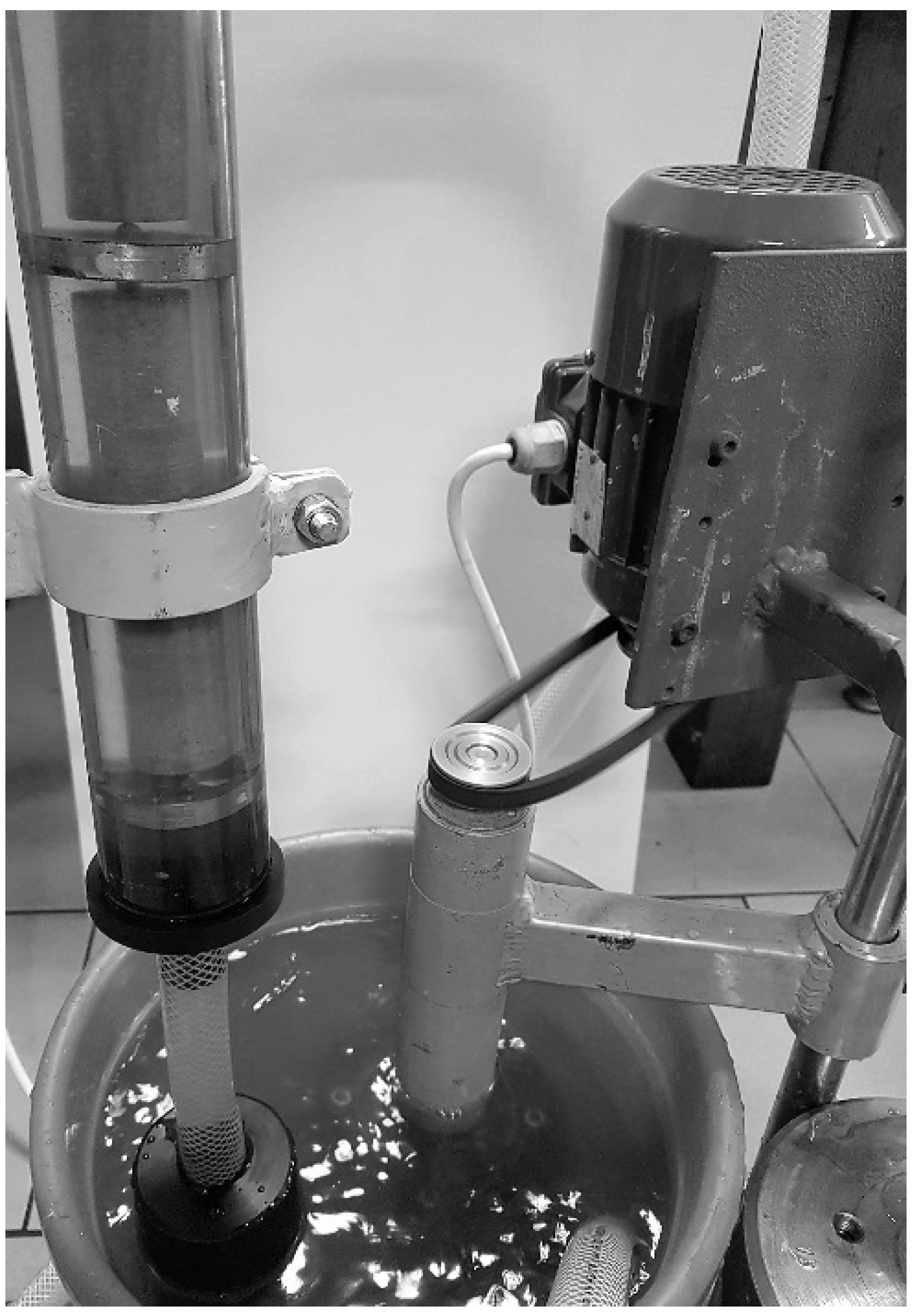
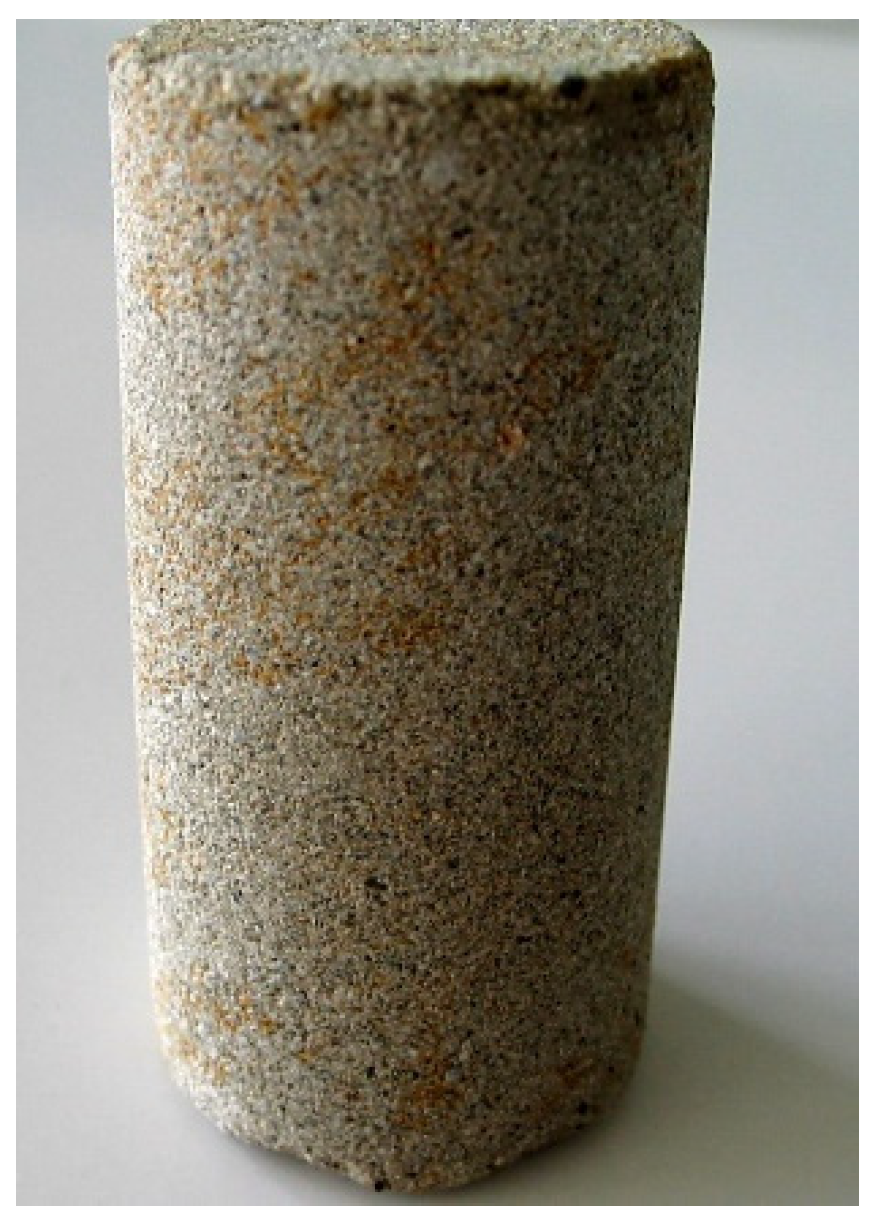

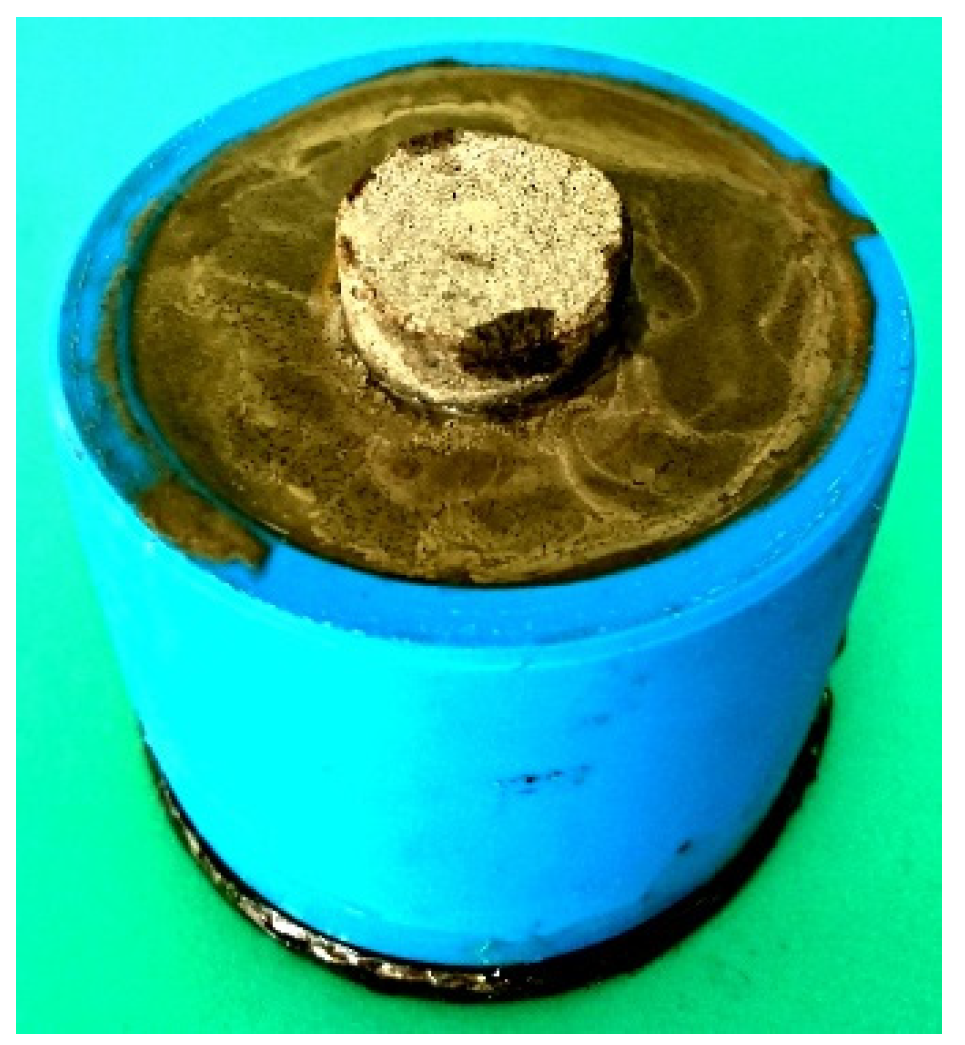
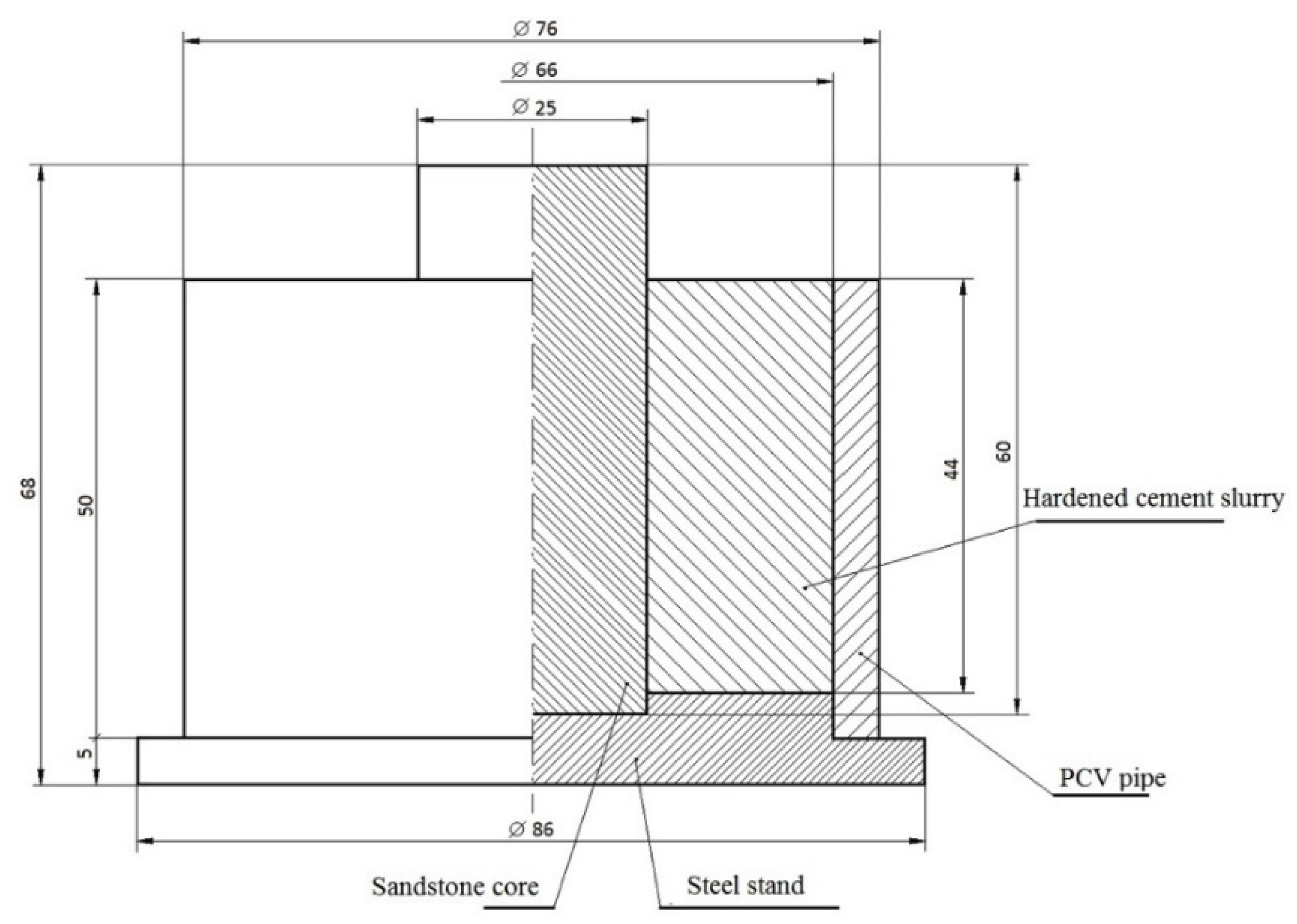
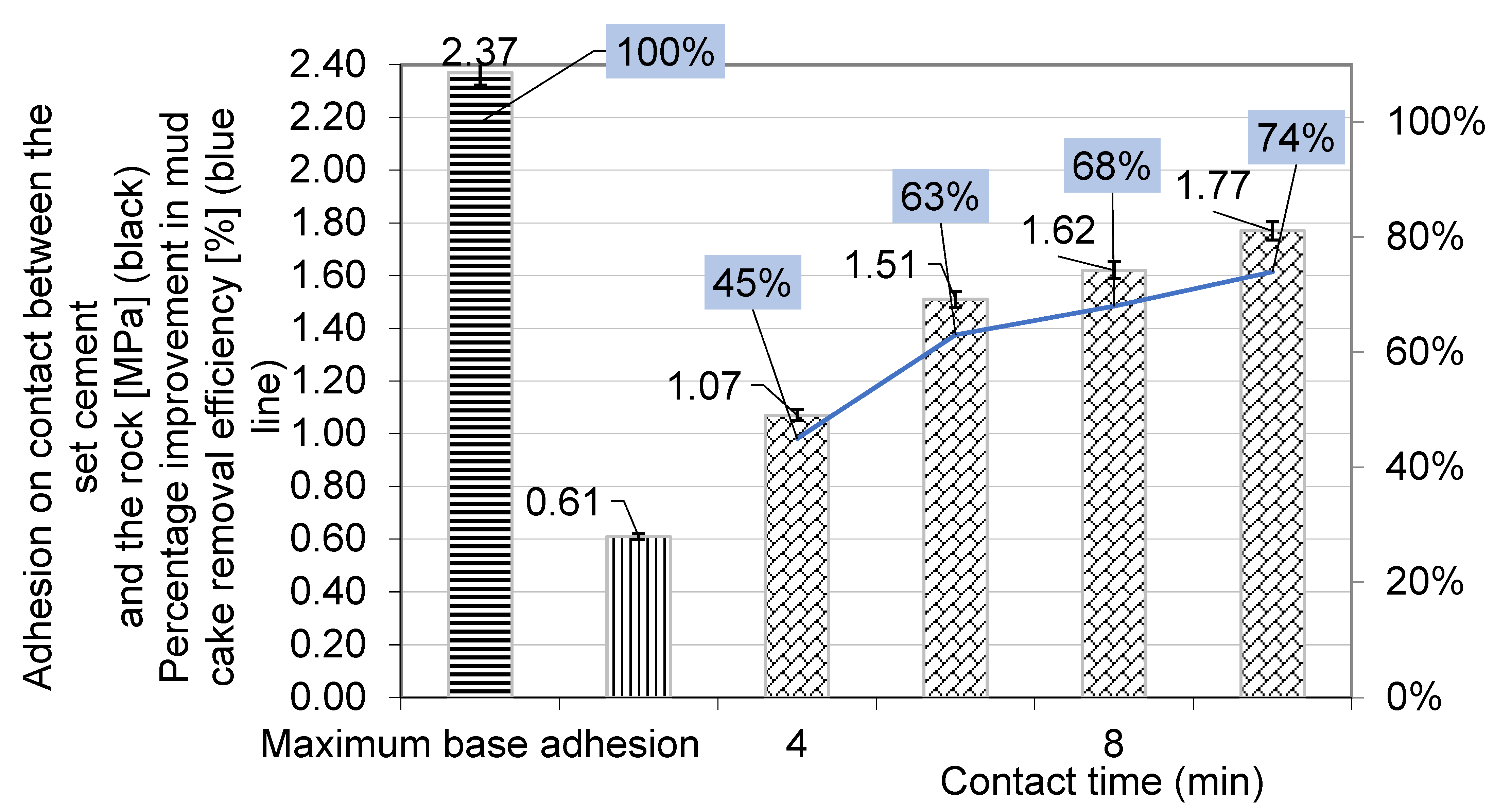
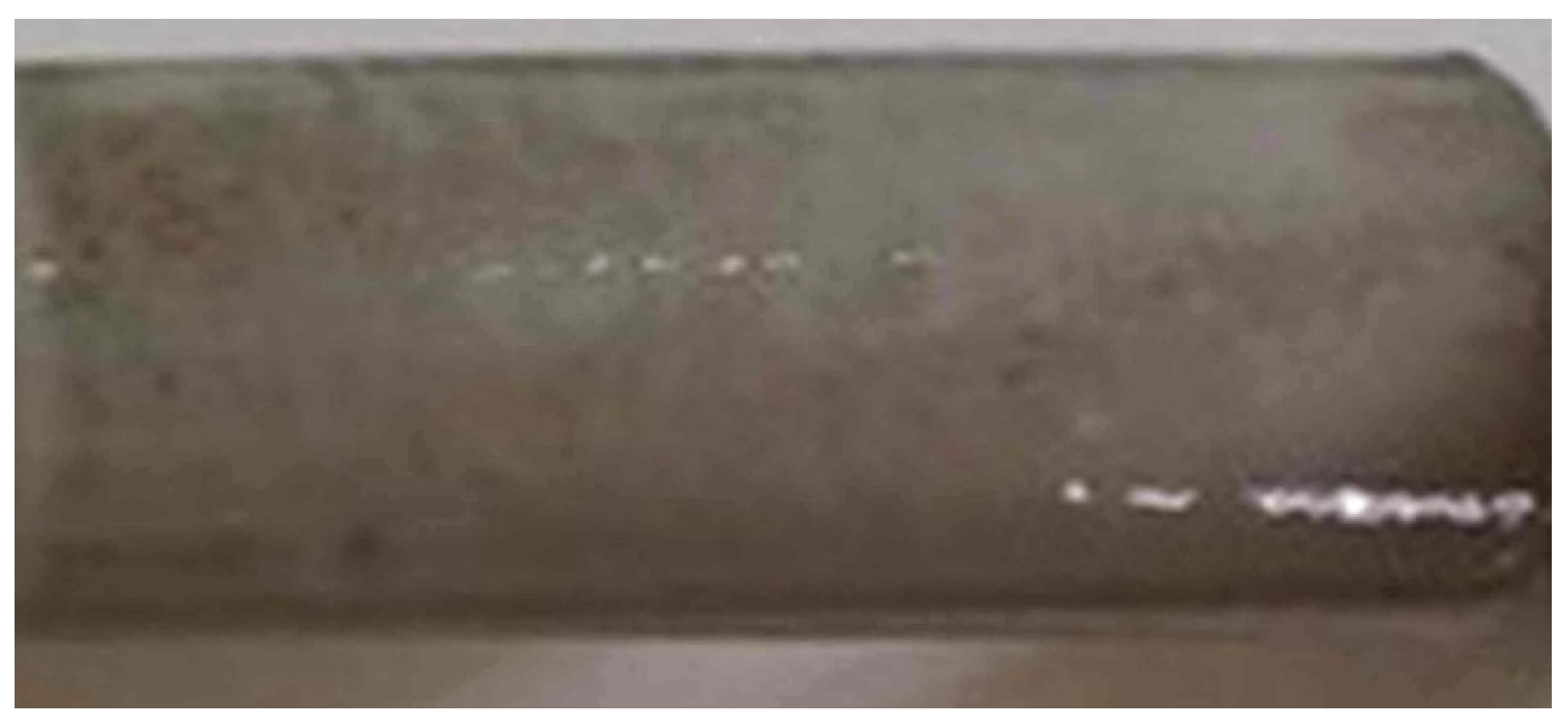

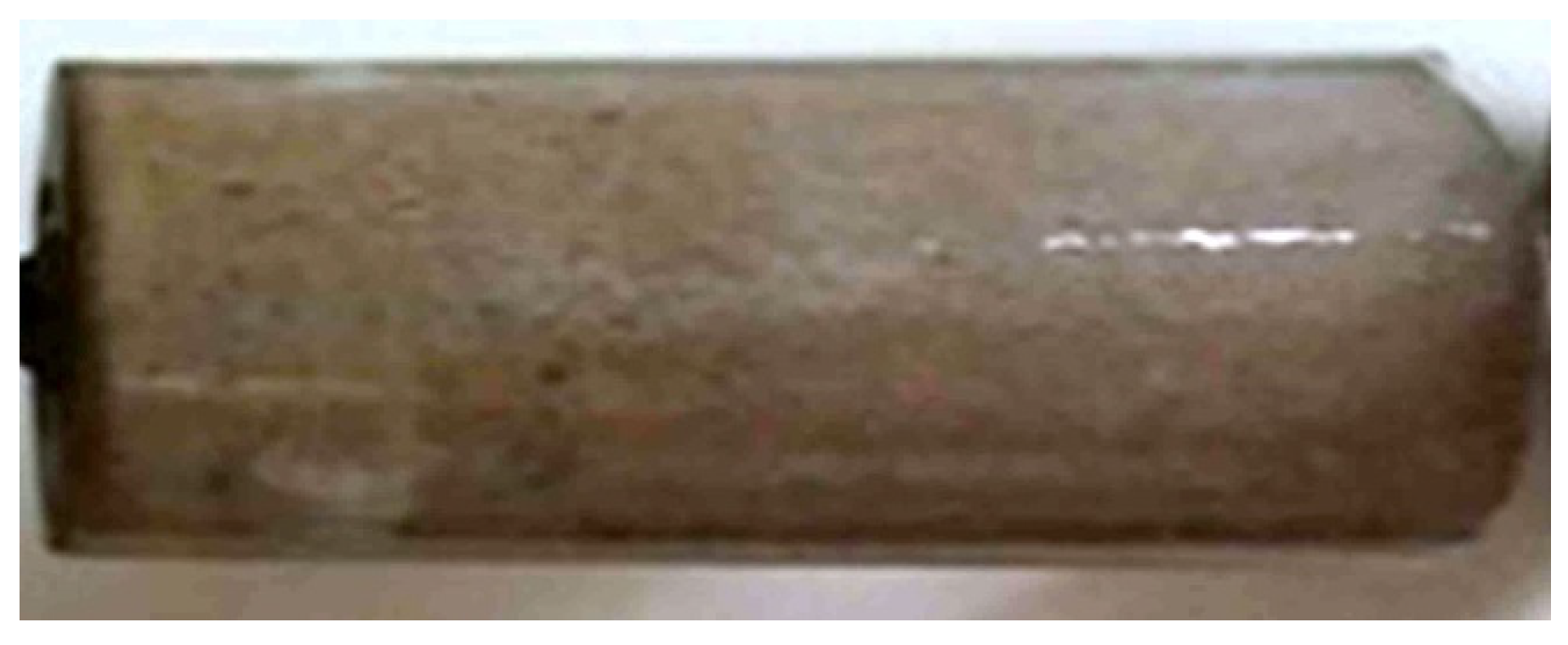
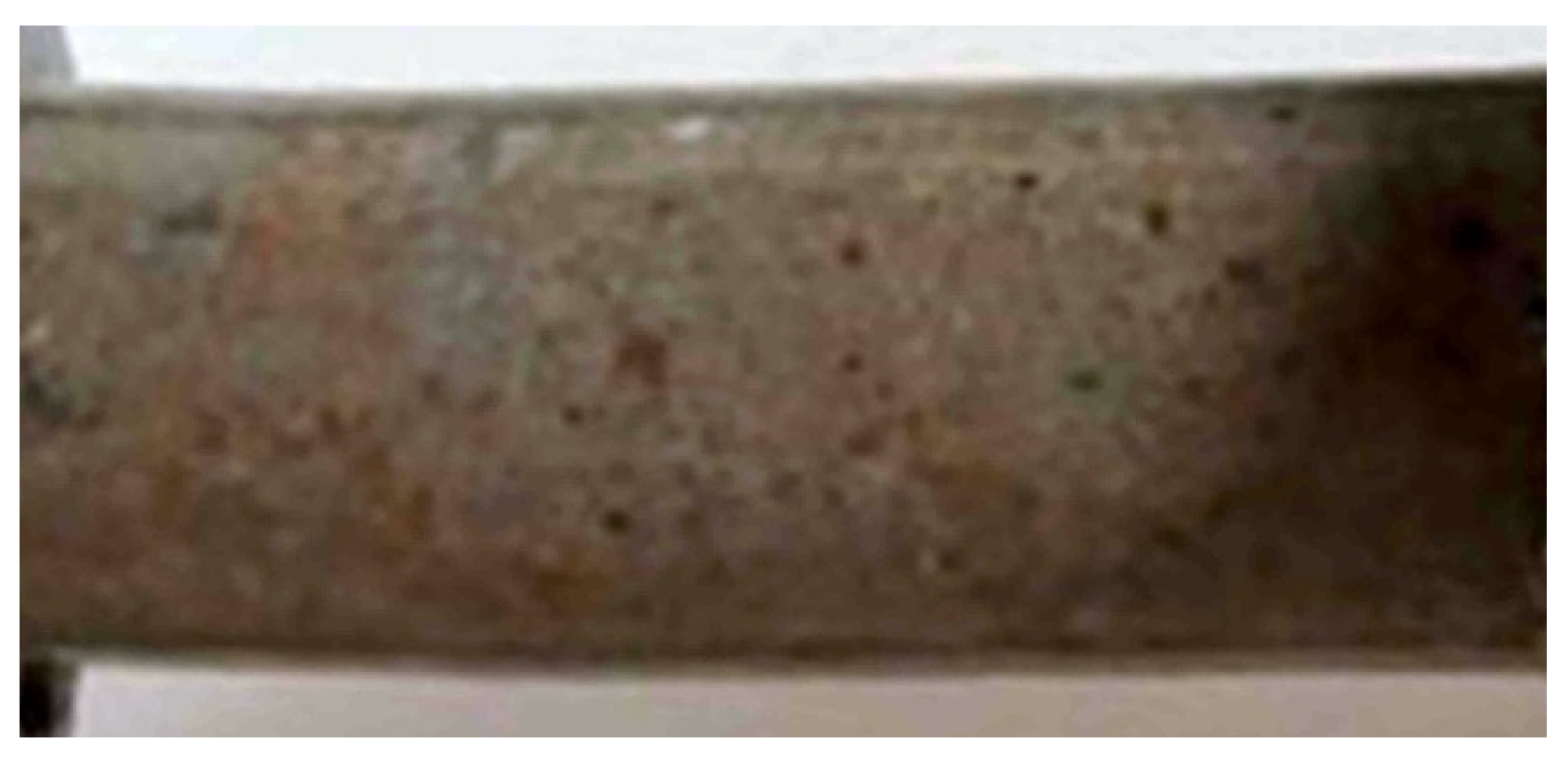
| Ingredients | Concentration Percent by Weight |
|---|---|
| Biocide | 0.2 |
| Xanthan gum | 0.3 |
| Carboxymethylcellulose | 2.5 |
| Partially hydrolyzed polyacrylamide (polymeric clay hydration inhibitor) | 0.2 |
| KCl (potassium chloride as an ionic inhibitor) | 0.5 |
| Ingredients | Percent by Mass of Cement |
|---|---|
| Water–cement ratio | 0.45 |
| Plasticizer | 0.2 |
| Latex | 10.0 |
| Stabilizer | 1.0 |
| Defoaming agent | 0.5 |
| Anti-filtration agent | 0.2 |
| Setting accelerator | 4.0 |
| Microcement | 10.0 |
| Cement CEM I 42.5R | 100.0 |
| The Force Required to Break the Adhesion (N) | Adhesion of Cement to the Sandstone Core (MPa) | |
|---|---|---|
| Maximum control value | 8.2 | 2.37 |
| Minimum control value | 2.1 | 0.61 |
| Contact Time (min) | 2 min | 4 min | 6 min | 8 min | 10 min | 12 min |
|---|---|---|---|---|---|---|
| Adhesion to the sandstone core (MPa) | 1.07 | 1.51 | 1.62 | 1.77 | ||
| Percentage change in the adhesion in relation to the maximum baseline adhesion (%) | −68% ± 0.5% | −55% ± 0.5% | −37% ± 0.5% | −32% ± 0.5% | −26% ± 0.5% | −24% ± 0.5% |
| Percentage improvement in mud cake removal efficiency (%) | +32% ± 0.5% | +45% ± 0.5% | +63% ± 0.5% | +68% ± 0.5% | +74% ± 0.5% | +76% ± 0.5% |
| Percentage change in the adhesion compared to the minimum baseline adhesion (%) | +23% ± 0.5% | +75% ± 0.5% | +146% ± 0.5% | +165% ± 0.5% | +189% ± 0.5% | +195% ± 0.5% |
Publisher’s Note: MDPI stays neutral with regard to jurisdictional claims in published maps and institutional affiliations. |
© 2021 by the authors. Licensee MDPI, Basel, Switzerland. This article is an open access article distributed under the terms and conditions of the Creative Commons Attribution (CC BY) license (https://creativecommons.org/licenses/by/4.0/).
Share and Cite
Kremieniewski, M.; Kędzierski, M.; Błaż, S. Increasing the Efficiency of Sealing the Borehole in Terms of Spacer Pumping Time. Energies 2021, 14, 6702. https://doi.org/10.3390/en14206702
Kremieniewski M, Kędzierski M, Błaż S. Increasing the Efficiency of Sealing the Borehole in Terms of Spacer Pumping Time. Energies. 2021; 14(20):6702. https://doi.org/10.3390/en14206702
Chicago/Turabian StyleKremieniewski, Marcin, Miłosz Kędzierski, and Sławomir Błaż. 2021. "Increasing the Efficiency of Sealing the Borehole in Terms of Spacer Pumping Time" Energies 14, no. 20: 6702. https://doi.org/10.3390/en14206702
APA StyleKremieniewski, M., Kędzierski, M., & Błaż, S. (2021). Increasing the Efficiency of Sealing the Borehole in Terms of Spacer Pumping Time. Energies, 14(20), 6702. https://doi.org/10.3390/en14206702






